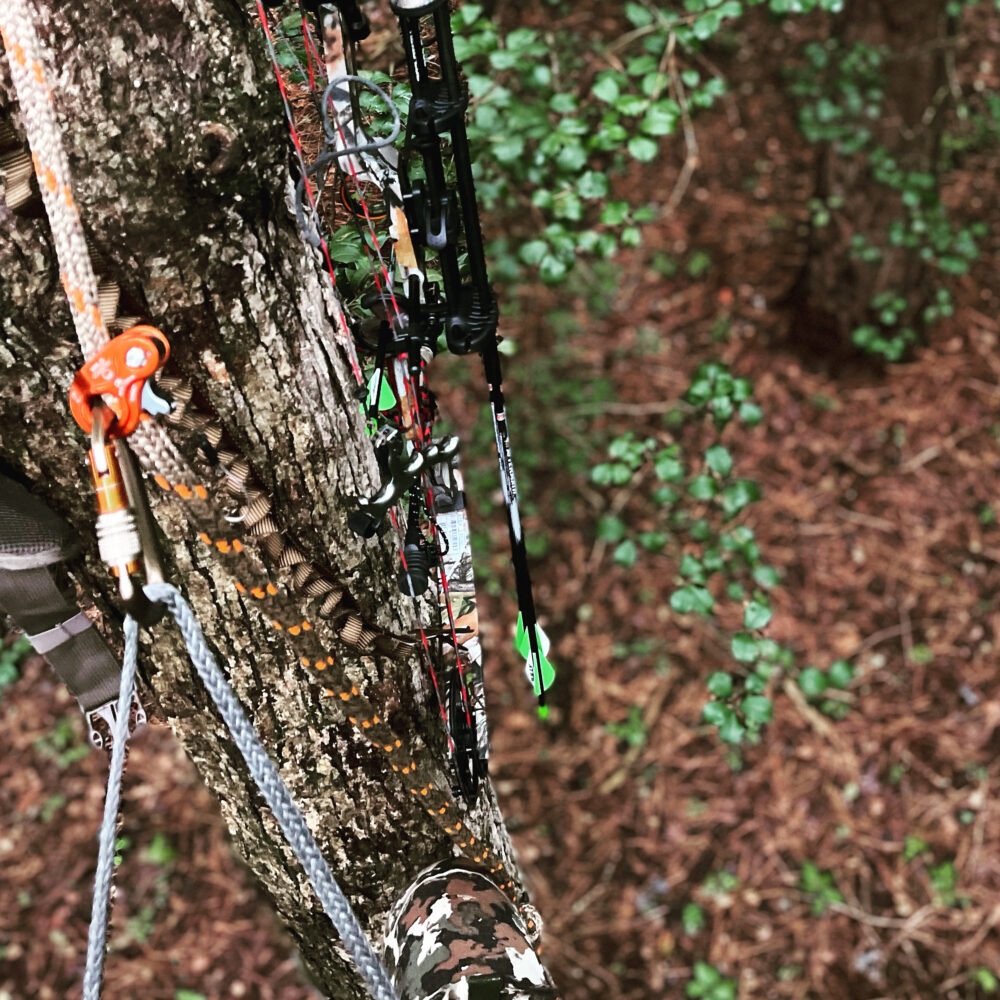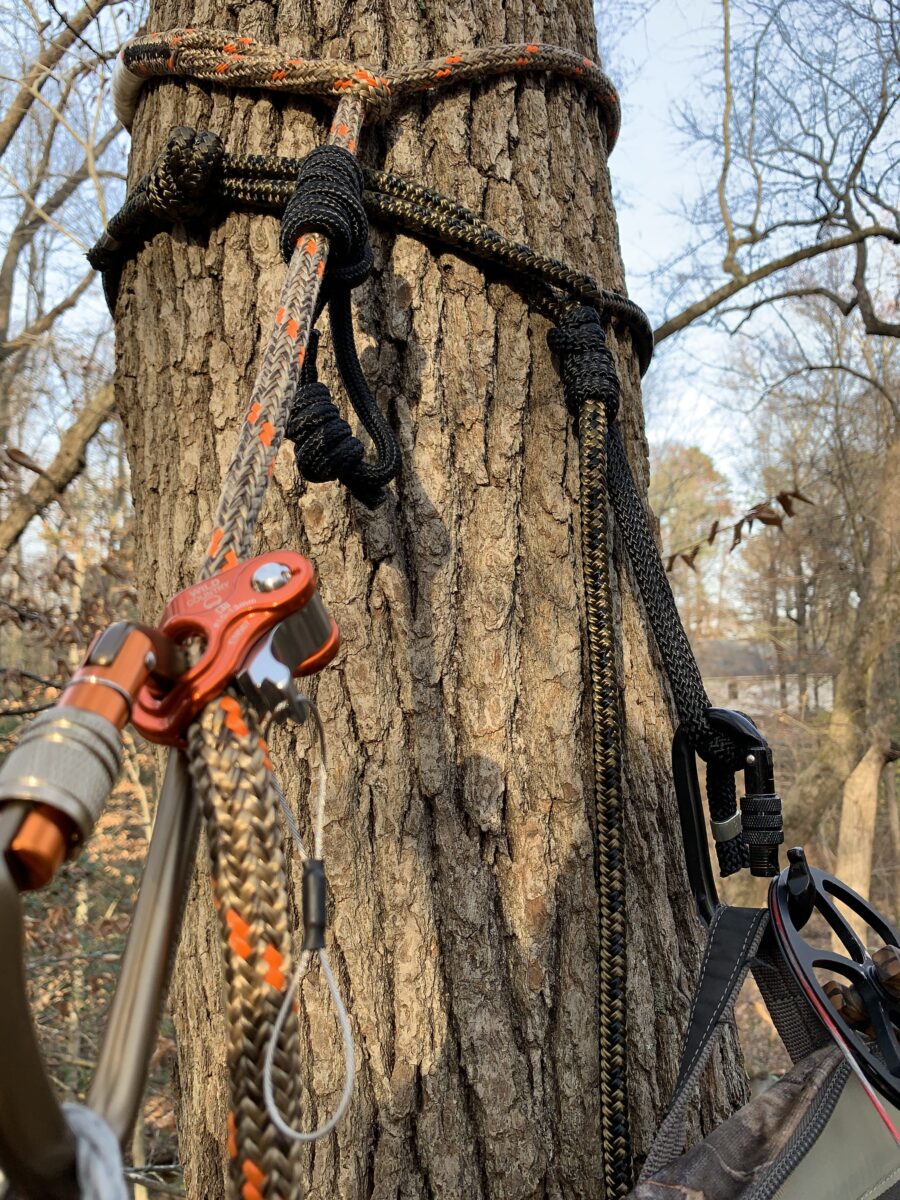
The author in his saddle setup.
By James Moffitt
Photos by James Moffitt
A couple of years ago, I switched from a traditional climbing stand to a tree saddle. Like many hunters, I was tired of lugging a heavy climber around and wanted to see if there was a better way to get into an elevated position. I spent most of the summer researching tree saddles and weighing the pros and cons before ultimately making the switch.
If you’re thinking about changing how you get into the tree in the upcoming season, looking into a tree saddle system may be a good idea for you as well. Below is an honest review of the pros and cons I considered before making the switch, along with some insights as I go into my fourth season hunting from a tree saddle.
The Pros
Compact & Light
Some of the best benefits of hunting with a tree saddle are the space and weight savings. As a hunter who frequents both urban archery theaters and public lands, I make it a point to keep my entire kit as light and portable as possible. Tree saddles are great for this—mine rolls up to the size of a small sleeping bag and weighs just a few pounds including ropes, carabiners, and ascenders. On most hikes in, I put the saddle on before starting, reducing the time I’m digging around my pack and helping me get in the tree faster.
Climbing Ability
Saying you can climb anything may be a bit of an oversell, but it’s not far off. As a rule of thumb, if the tree is as big around as a basketball and relatively straight, you can get up it. Tree saddles offer a very nimble and flexible climbing platform. You can easily pass around obstructing branches, in between tightly grouped trees, and through other obstacles not easily handled with a climbing stand. This is an incredible asset in urban hunting environments or for archery hunters that want to get in tight to a bedding area, stream crossing, or rub.
Shot Opportunities
With some practice, saddles offer you nearly 360 degrees of shooting lanes. Unlike a traditional climber that locks into one direction on the tree, saddles allow you the opportunity to “swing” around your platform to take a shot. It should be noted that there’s a learning curve with this shooting style, and it takes some practice to be able to comfortably execute a shot at extreme angles. In my personal experience, I’ve found that taking the extra time to set myself in the most likely direction for the most beneficial shooting lane is extremely helpful and something you need to pay attention to as a saddle hunter.

The view from a saddle.
Comfort
We’ve all dealt with the discomforts of a traditional tree stand. They allow for limited movement and adjustment, which can make all-day sits a suffer-fest. Saddles on the other hand, are designed to allow you to take up any position you choose. I’ve found that on especially long sits, I’ll change up my position every 30 minutes or so. With a simple adjustment on my ascender, I can stand more upright and take pressure off my hips or sit way low and back in the saddle, hanging further off the tree and giving my knees and feet a break. Once you learn to trust your tether, which can take some time, I find that you’re able to hang all day without developing any hotspots.
A potential downside to saddles, however, is the need for some kind of knee pads, especially on longer sits. You use your knees a lot to brace yourself against the tree and push off when changing positions. I tried to resist spending extra money on knee pads the first couple of years I hunted in a saddle, but eventually got tired of my knees looking like they did during my skateboarding days and pulled the trigger on some pads. It made a world of difference, but is something to consider when thinking about switching to a tree saddle.
The Cons
Cost
Getting into saddle hunting is not cheap. Even if you already have a set of climbing sticks, you’re looking at spending money on a saddle, tether line, safety line, platform, knee pads (trust me), and ascenders.
With most manufacturers, you can buy a kit that includes your ropes and saddles ranging from $400-$600. Depending on the accessories you buy and the style of saddle you purchase, the price can go even higher. This is a definite barrier to entry for saddle hunting and makes it a pretty significant up-front investment for something you can’t easily try before you buy. Additionally, your ropes and ascenders should be checked every season and replaced if damaged, which can add up quickly if you’re hard on your gear.

The rope system for a saddle setup.
Learning Curve
There is absolutely a learning curve associated with saddle hunting. Both ascending and descending take practice. I started by watching YouTube videos on how other hunters were getting up and down trees and then took those learnings into the field. I’ve found that creating a system, keeping all of your climbing equipment in the same place every time, and practicing are crucial to getting up the tree safely and quietly.
Learning to be an effective climber with a saddle takes some dedication and sweaty afternoons in the summer shuffling up and down a convenient tree.
Once you’ve mastered the basics of climbing the tree, you’re then faced with the additional difficulty of learning how to shoot from the saddle. Again, practice, practice, practice. This time requirement can be a real downside if you’ve got a tight schedule or other obligations to tend to and prefer to leave hunting off until the season starts.
Conclusion
Hopefully, this breakdown will help you make an informed decision when choosing whether or not saddle hunting is right for you. If you’re considering a saddle for the fall, the best piece of advice I can give is to start now—get your setup dialed and start practicing. It will pay off in dividends when you’re in the field.
James Moffitt is the founder of TrailHead Creative, a branding and content agency based in Richmond. He’s an avid outdoorsman, hunter and angler and takes any opportunity he can to spend time outdoors with his Labrador retriever, Huxley.


